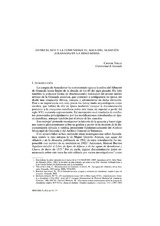Entre el Rey y la comunidad: el agua del Albayzín (Granada) en la Edad Media

Ver/
Autor
Trillo, Carmen
Editor
Facultad de Filosofía y Letras. Departamento de Ciencias de la Antigüedad y Edad MediaFecha
2012Materia
Al-AndalusGestión del agua
Comunidad urbana
Madina Gamáta
Water management
Urban community
METS:
Mostrar el registro METSPREMIS:
Mostrar el registro PREMISMetadatos
Mostrar el registro completo del ítemResumen
En este trabajo analizamos una acequia medieval, la de Aynadamar, utilizada en época andalusí en la ciudad de Granada, desde el punto de vista histórico. Hace¬mos hincapié en un anáfisis social, estudiando sus orígenes, forma de organización, objetivos a los que atendía y mantenimiento. Para ello se ha utilizado tanto docu¬mentación editada como inédita, en árabe romanceada y en castellano, perteneciente a archivos locales y nacionales. Del estudio puede concluirse que, seguramente entre el siglo XI a la mitad del XIII, la acequia fue estructurada siguiendo unos paráme¬tros temporales (tumos coincidentes con oraciones islámicas) y espaciales islámicos (siendo su principal objetivo la alcazaba y las mezquitas, entre otros). Asimismo, se refleja una intervención del rey en esta organización, privilegiando la Alcazaba Qadíma y sus huertas frente al uso del agua de los vecinos del Albayzín en sus casas, si bien sus necesidades están cubiertas por una red de aljibes. No obstante, aquéllos a su vez tienen asegurados sus derechos como comunidad frente a otros habitantes de la ciudad de Granada. This paper analyzes a medieval ditch, “acequia de Aynadamar”, used in the Andalusian period in the city of Granada, from the historical point of view. We emphasize social analysis, studying their origins, forms of organization, needs ser- ved (irrigation, cistems, and so on) and maintenance. To do this, it has been used published documentation, sometimes arabic, sometimes castifian, as well as unpu- blished documentation coming from local and national archives. From the study can be concluded that, surely among the eleventh century and the middle of XIII, the canal was structured according to islamic temporal parameters (irrigation shifts coincided with Islamic prayers) and spatial criteria (its main aim was the royal palace and mosques, among others). As well, it is demonstrated the king’s intervention in this organization, favoring the royal palace (“Alcazaba Qadima”) and their gardens above Albayzín neighbors. However, their needs are met by a network of cistems. On the other hand, these neighbors had secured its water rights about Aynadamar as opposed to other inhabitants of the dty of Granada
